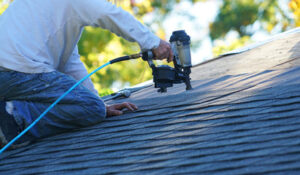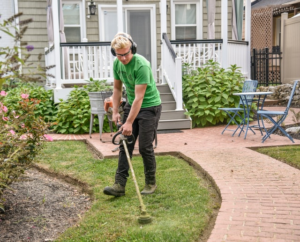Many homeowners don’t realize their roof is damaged until something goes wrong. This is because a damaged roof can be hidden from view by bushes, trees and other structures surrounding the house.

Look out for water stains on your ceiling and other signs of leakage. Having your roof repaired as soon as possible will help prevent further damage.
Keeping your roof in a good condition ensures that it protects the rest of your home, preventing further damage and saving you money. However, the cost of repairing or replacing your roof can be expensive and require a lot of planning and saving.
Typically, the cost of repairs depends on the size and type of your roof, as well as how extensive the damage is. In some cases, you may also need a permit for the job. Luckily, there are numerous DIY guides and tutorials that can help you save on professional fees. However, it is important to assess your own abilities and the complexity of the task before attempting any repairs on your own. Moreover, you should always take safety measures into account, as an inexperienced or unsafe approach can result in disastrous consequences.
It’s advisable to schedule regular inspections of your roof by a qualified professional. This will help you identify issues that need urgent attention. For example, if you notice signs of leakage or loose shingles, they should be fixed immediately to avoid further damage and costly repair costs.
Furthermore, a thorough roof inspection can reveal other issues that you might not be aware of, such as rot or mould. Taking care of these issues early on can significantly reduce your roofing maintenance costs in the long run.
If your roof is aging and has sustained significant damage, you will likely need to replace it in the future. The best way to minimize the cost of replacement is to carry out timely repairs and maintenance.
Replacing your roof can be very costly, depending on the type of materials used and any labour costs involved. To reduce your costs, it’s a good idea to use high-quality roofing materials and hire a reputable contractor to ensure that the work is done properly.
Another great way to save money on roof repair is to pay off any debts with high-interest rates before starting to save for the project. This will free up a significant chunk of your income that can then be diverted towards the repair work.
Reduce Energy Wastage
In addition to protecting a home from harsh weather elements, roof repair and maintenance also help increase energy efficiency. This is achieved by preventing air leaks and heat loss, ensuring the right amount of insulation, and promoting sustainable practices. A poorly maintained roof is a major contributor to high energy bills, but regular roof inspection and timely repairs can prevent these issues and provide significant savings.
A leaking or damaged roof allows conditioned air to escape and external air to infiltrate, which causes HVAC systems to work harder to maintain desired indoor temperatures. This translates to higher energy consumption and costly bills. Roof repair and maintenance can help prevent these problems by sealing air leaks, insulating the roof, and installing proper ventilation systems.
Another way that Roof Repair can reduce energy wastage is by allowing homeowners to choose reflective materials and roofing solutions. These options deflect sunlight and minimize the amount of heat absorbed, which significantly cuts down on air conditioning usage and costs.
When insulation is a concern, roof repair can be used to add new layers or replace existing ones. The right insulation will regulate temperature and ensure that conditioned air stays inside the house and is not lost through ventilation. This will lower energy costs and increase comfort levels.
The gap-sealing capabilities of roof repair can have a huge impact on energy efficiency. Gaps in the roof allow heated air to escape in winter and cooled air to seep in during summer, which leads to uneven temperatures and excessive reliance on HVAC systems. Roof repair can ensure that the entire roofing structure is tightly sealed, preventing air leaks and a comfortable and sustainable living environment.
The relationship between gap-sealing roof repair and energy efficiency is clear. A well-maintained roof is a reliable contributor to home energy efficiency, helping to cut down on energy costs and create a greener and more environmentally friendly living environment. A reliable roof repair service, such as Roof Fix Houston, offers various roofing solutions that can address gaps and vulnerabilities to improve energy efficiency. This includes reflective coatings and materials, cool roofs, and solar panels.
Enhance the Value of Your Home
The roof is one of the most vital components of a building, protecting the structure and its occupants from weather conditions, wear and tear, and other environmental factors. It is a complex system that requires regular inspection and maintenance to ensure its structural integrity and safety. Through preventive roof repair, you can address small issues before they escalate into larger problems. This allows you to save money in the long run and avoid costly repairs or replacements later on.
If you plan to sell your home in the future, a well-maintained roof will increase its value. A ragged roof looks unattractive and can scare off potential buyers. If a home inspector finds damage, they may either recommend further inspections or ask you to pay for the cost of a new roof before closing the sale.
However, if you perform regular maintenance and keep records of the work done, you can show prospective buyers the history of your roof’s health. This can help you get the best price for your property in a competitive market.
Prevent Further Damage
The roof is a stalwart defender of your home, shielding you from the elements and helping maintain structural integrity. However, it is also one of the first parts of your house to suffer from wear and tear due to heavy rains, hail, and strong winds. As a result, your roof needs regular maintenance to prevent damage. This includes patching up small leaks and holes and preventing moisture from seeping into your living space.
When left unattended, small issues like leaks and holes can lead to extensive and costly damage to your roof and your home. For instance, ignoring a minor roof leak can cause mold growth and water damage to your ceilings and walls. It can also lead to rot and even compromise indoor air quality.
Aside from addressing leaks and holes, regular roof repairs can help enhance the energy efficiency of your home. An inefficient or damaged roof allows conditioned air to escape and outside air to infiltrate, which requires your HVAC system to work harder. By repairing and insulating your roof, you can minimize air leaks and reduce energy wastage, thus saving money on utility bills.
It is important to differentiate between surface and structural damage, and determine whether repair or replacement is the best option for your roof. Generally, a professional roofing contractor will recommend replacing your roof if it has sustained extensive storm damage or a significant amount of shingle loss. Extensive structural damage to your roof may require an entire roof removal, which is more expensive than a simple repair.
Some types of structural damage to your roof can be repaired by a qualified professional, such as fixing a leaning chimney, re-caulking vents and pipes, and reinforcing sagging sections of the roof. However, if your roof has suffered major damage, a full replacement is the only option to ensure your home’s safety and comfort. This is especially true if you have experienced widespread shingle loss, extensive leaks, or visible structural damage. An expert roofer will inspect the extent of your roof’s damage and recommend a course of action accordingly.



